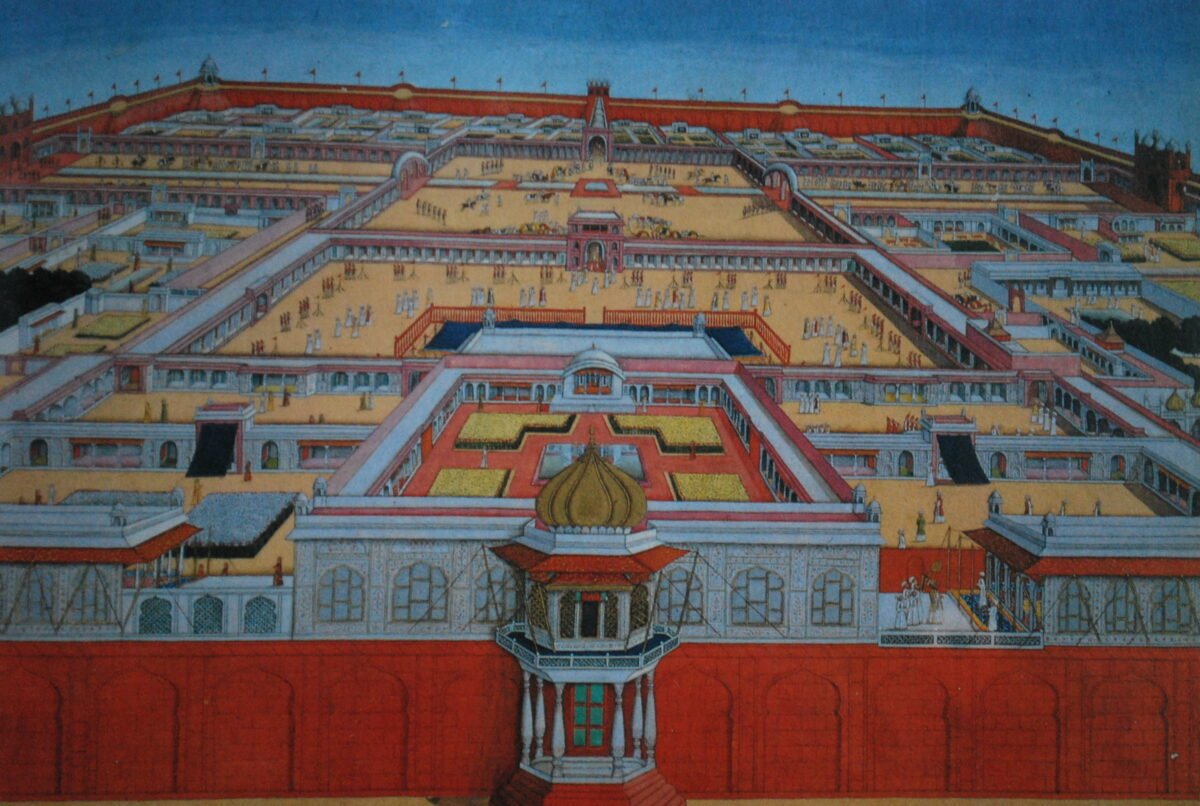Space by D.K. Ching
Space is not just an area but it possesses certain meanings. These meanings are defined by its context, its dimensions and how people perceive and react to it. This concept was propounded by D.K. Ching in the context of architecture. Hence a building is defined by how people use it, the meanings that they attach to it. It is not just brick and mortar. It is an experience in itself. This experience is also used to portray and assert power, hierarchies, intimacies and legacies. The Red Fort or Lal Quila in Delhi is a great example of the concept of space as defined by D.K. Ching.

The Red Fort as a bounded space
Applying Ching’s concepts one can see that the massive and strong red boundaries of the monument give it a clear distinction from the outside world and marks its present identity. The monumental buildings inside give a clear sense of a large enclosed space which can only be controlled and maintained by an empire wielding such power. It is a constant reminder to both people inside it and outside it of the magnitude of power of the Mughal empire.

An Interactive Promenade
As one moves through the grounds of the fort one can clearly see the usage of the space for a host of clearly distinguished activities. There are separate spaces for the markets, stables, kitchens, courts etc.This usage is marked by the layout of the space and the architecture of the place. It also defined the use of the material and the placements of the windows and doors.The public buildings for instance are large, bright and airy whereas the private quarters are smaller and more regal in terms of the form and materials used. The layout of the fort creates a hierarchy between the public and the private as one moves from the outer areas to the inner monuments.

An experiential space of power and hierarchy
Red Fort has been defined as a “social space” by architect Anisha Shekhar Mukherji. This is because the fort was a place for the public to interact with the empire and amongst themselves. The fort housed large open spaces marked by massive structures. It had open gardens, markets and the courtrooms where the public regularly interacted with the state and its power symbols. Hence the spaces though housed the general public but their interaction with it constantly reminded them of being inside an enclosed and powerful state.
The hierarchy was also clearly marked in the architecture as one moves from large public spaces to more private ones. The grandeur of the open court houses like the Diwan-i-Aam are replaced by more intricate and intimate monuments for the private use of the royalty.

Conclusion
The Red Fort is a great example of the use of space in giving meaning to the boundaries of a building. Applying the concept of space as propounded by D.K. Ching one can see the use of space to define a hierarchy between the public and the royalty. It also uses the monuments and the overall layout to create a sense of grandeur and awe which can only be achieved by a powerful empire. The intentions of the makers are distinctly realised in the sense that the fort till today remains the symbol of the state.
References:
- Anisha Shekhar Mukherji, “The Secret of the Qila-i-Mubarak”, Text of the Lecture delivered at IIC, AMBI, 21 April 2012, https://ambiknowledgeresources.wordpress.com/new-writings/architectural-history/the-secret-of-the-qila-i-mubarak-2/
- Ching, Francis DK., “Architecture: Form, space, and order”, John Wiley & Sons, 2023
- File:Diwan-i-Aam, Red Fort, Delhi, https://commons.wikimedia.org/wiki/File:Diwan-i-Aam,_Red_Fort,_Delhi_-_2.jpg
- Interior view with the Stream of Paradise towards the Khas Mahal (before 1854, by Ghulam Ali Khan) https://en.wikipedia.org/wiki/Diwan-i-Khas_%28Red_Fort%29#/media/File:Ghulam_Ali_Khan_014b.jpg
- Lal Quila/Red Fort Complex, Jogamaya Devi College, https://jogamayadevicollege.ac.in/uploads/1585044535.pdf
- Red Fort: A symbol of splendour, Google Arts and Culture, https://artsandculture.google.com/story/red-fort-a-symbol-of-splendour-incredibleindia/dgWhNOimJNNcLg?hl=en
- Red Fort – The ‘Qila-I-Mubarak’ ,Namaste India Trip https://www.namasteindiatrip.com/blog/red-fort-delhi/
- Red Fort, New Delhi, MAP Academy, https://mapacademy.io/article/red-fort-new-delhi/
- Zenaira Bakhsh, “Why Red Fort isn’t like an emperor’s palace—New book explains its intelligent architecture”, The Print, https://theprint.in/feature/around-town/why-red-fort-isnt-like-an-emperors-palace-new-book-explains-its-intelligent-architecture/1991561/
